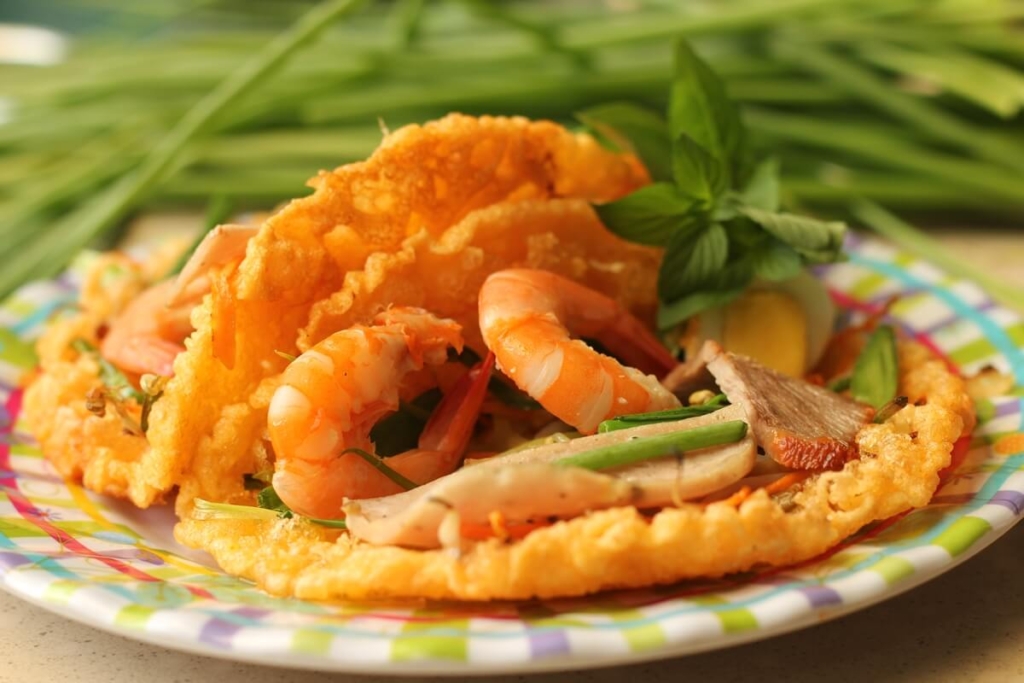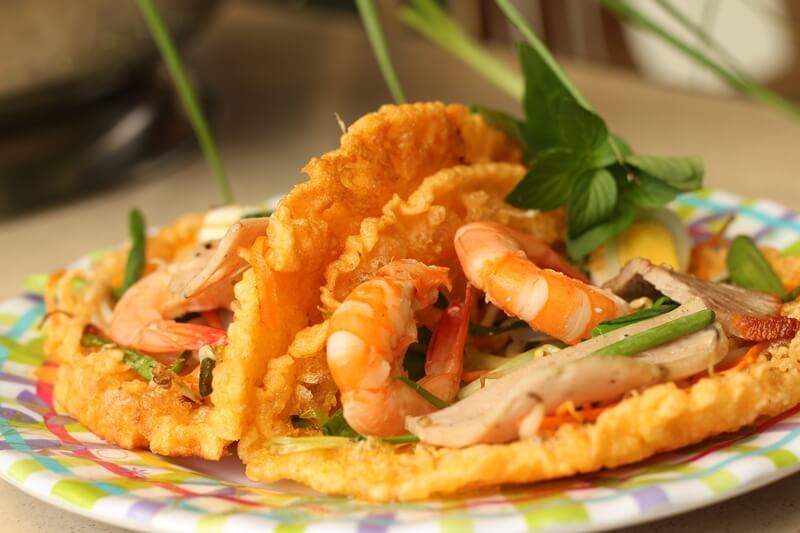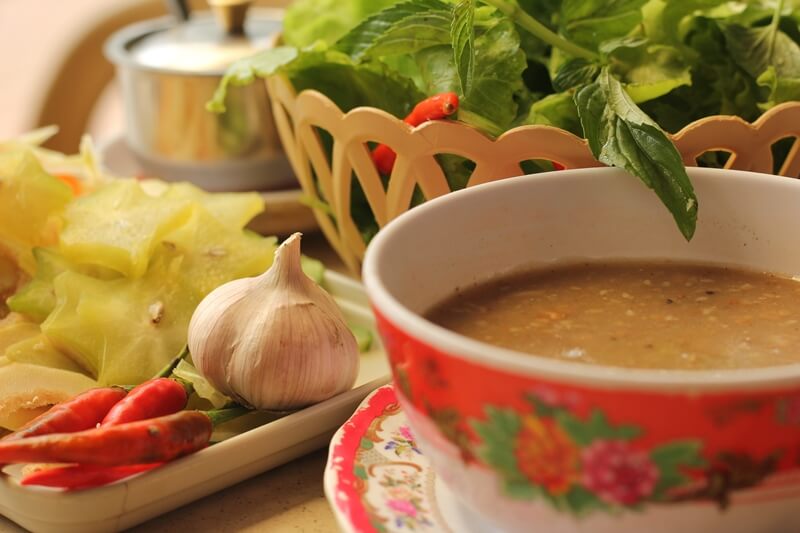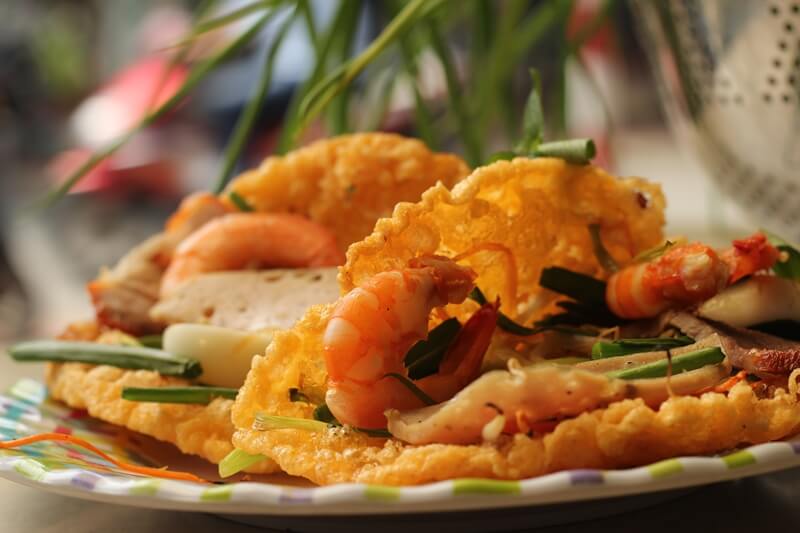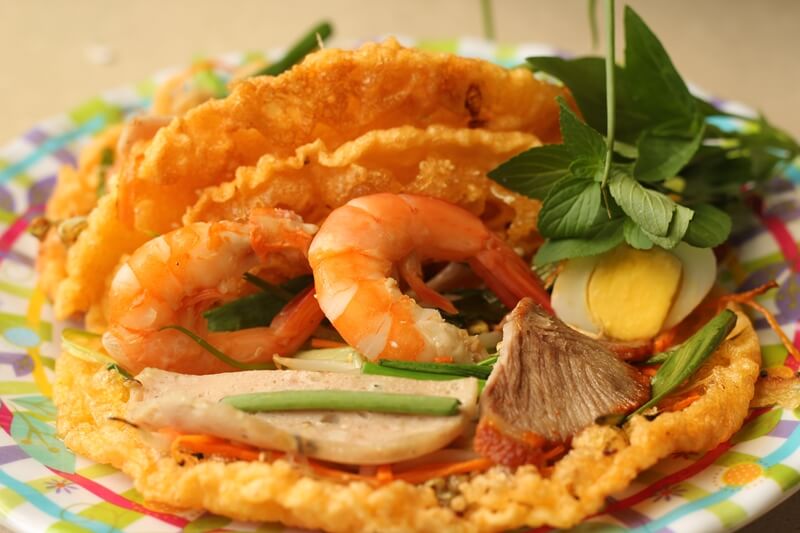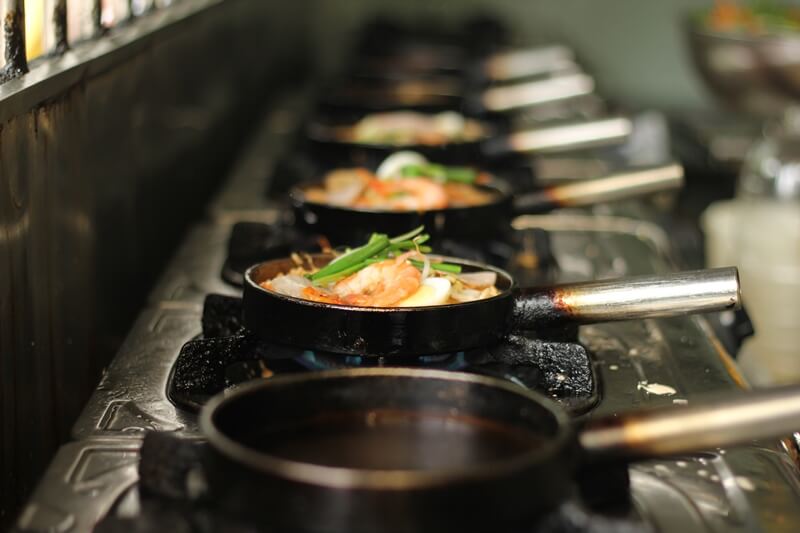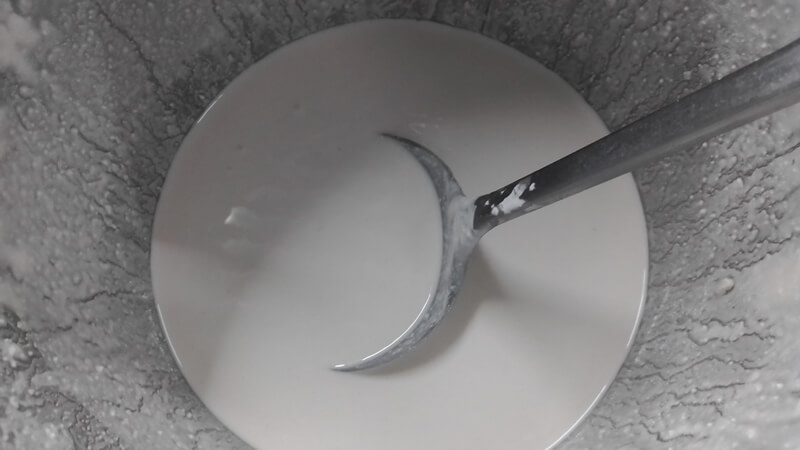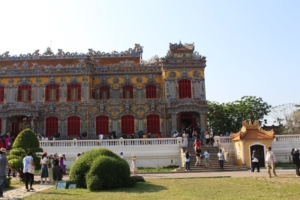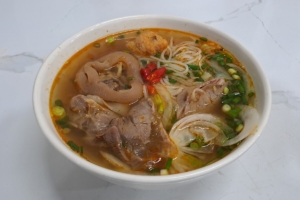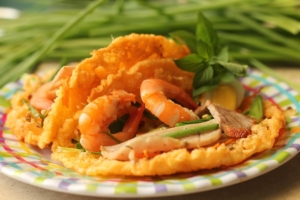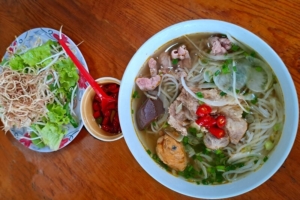Banh Khoai Hue, also called Hue Pancake, clearly shows the unique skills of the royal chefs of the ancient Nguyen Dynasty.
It includes creative changes to turn the popular Banh Xeo into Banh Khoai with bold royal colors, becoming a magnificent royal dish. These variations include the size, base, filling, dipping sauces, and accompanying vegetables.
1. Characteristics of Khoai cake
Banh Xeo is made from finely ground rice flour, fried until golden brown in a pan, with a few slices of meat or shrimp fillings on top. This dish is served with raw vegetables available in the garden and dipped in chili garlic fish sauce.
But when arriving at the land of Hue Imperial Citadel, this food took on the characteristics of a royal meal, one level up.
Each pancake needs to meet the criteria:
- require only a small amount, but must be delicious
- have various flavors
- be rich in nutrients
- be beautiful and luxurious.
Then, Banh Khoai was born, based on Banh Xeo.
Compared to Banh Xeo, Banh Khoai is smaller in size. The crust is crispy and spongy.
The topping filling has shrimp, meat, eggs, pork, meat pie (Cha), carrot slices, and bean sprouts.
In addition to the green raw vegetables, it is indispensable to have a few slices of young fig, sour star fruit, and pickles of carrots and papaya.
The dipping sauce must be a sophisticatedly prepared broth, ensuring a unique and distinct flavor.
To have a tasty and correct standard requires the chef to fry Hue pancakes in specialized pans. The cast iron pans have great heat resistance and excellent adhesion resistance. This feature helps the pancakes have a crispy, spongy base, evenly golden brown, and not burn the edges.
Over time, Banh Khoai is today a popular dish loved by all classes of Hue people. The pancake with an inviting filling layer is presented on the dining table with an eye-catching golden base. The accompanying vegetables are fresh and attractive with a bowl of greasy, richly fragrant sauce.
2. How to eat Banh Khoai Hue
Unlike Banh Xeo, when eating Banh Khoai, people do not roll the cake with raw vegetables on thin rice paper. Because Banh Khoai has a thick filling, while its base is crispy and small, it is not suitable for rolling.
Also, the Hue Pancake on the plate is usually folded in half, loosely covering the filling inside.
People often use scissors to cut Banh Khoai into two halves. The diner puts on the pancake filled with a little sauce, a few stalks of papaya, sweet and sour carrots, figs, star fruit, and some raw vegetables.
Normally, people use their hands to hold the pancake from the plate to eat. A few others use chopsticks to pick up pancakes. Both of these ways of eating are suitable. However, eating with chopsticks seems to be a bit difficult, as the vegetables and sauce are easily separated from the thick pancake base.
You can come to Hong Mai Restaurant at 110 Dinh Tien Hoang Street, Hue City, Vietnam, to try tasty Hue pancakes.
3. Ingredients to make Banh Khoai Hue
Each perfect dish of Banh Khoai includes three main parts: pancake base, filling, and sauce.
3.1. Ingredients for the base:
The main ingredient to make this pancake base is rice flour. However, to make the base crispy and spongy, the chef will mix rice flour with a small amount of cornstarch, all-purpose flour, and tapioca starch.
The ratio of flour types will depend on each chef’s experience and recipe, but it is necessary to adhere to the principle that rice flour is the key ingredient.
In addition, the pancake can have eggs and turmeric powder, if desired.
3.2. Ingredients for the filling:
They include fresh shrimp, lean pork, quail eggs, meat pie(Cha), bean sprouts, papaya and carrot pickles, and green onion stalks.
3.3. Ingredients used to make Nuoc Leo (mixed sauce):
The mixed sauce is considered an important and indispensable part of creating the full flavor of the dish. Depending on the experience and secrets of each chef, there are typical recipes for preparing a bowl of sauce, which are not disclosed publicly.
But, it can be seen that the core ingredients to make this sauce include pork liver, fermented soy sauce, pureed roasted peanuts, roasted sesame seeds, glutinous rice flour (which can be replaced with cornstarch), fish sauce, and common spices.
3.4. Served with raw vegetables:
Depending on your preferences, you can prepare everything, including lettuce, herbs, figs, sour star fruit/or green mango, carrots, sweet and sour pickled papaya, and cucumber.
However, depending on your conditions, you can omit the above vegetables. Maybe just lettuce and herbs won’t affect the food quality too much.
4. How to make Banh Khoai
To make this standard pancake like the quality at Banh Khoai restaurant in Hue, the chef also needs a specialized cast iron pan besides the main ingredients.
This typical pan becomes difficult for those who want to make Banh Khoai at home.
Replace the specialized cast iron pan with the 15cm – 20cm wide non-stick pan you currently have. This alternative is the perfect solution to ensure you can still make your own Banh Khoai in your kitchen.
Start making it:
Step 1: Prepare ingredients:
– Steam fresh shrimp and peel them.
– Thinly sliced lean pork, marinated with a little salt, seasoning, pepper, a small amount of fish sauce, and minced purple onion. Let the meat soak in the spices for 30 minutes, then saute it.
– Hard-boiled quail eggs, peel and split in half. You can use quarters of chicken eggs instead of quail ones.
– Thinly sliced meat pie (if you don’t have the meat pie, you can replace it with cold meat).
– Blanch bean sprouts and spring onion stalks in boiling water.
– Minced pork liver.
– Roast peanuts until golden, peel, and puree.
– Fragrant roasted white sesame.
– Chopped purple onion and garlic.
Step 2: Cook the mixed sauce to dip the pancake
Put a pot on the stove, wait for the pot to heat up, add 1 tablespoon of cooking oil. When the oil boils, add minced onion and garlic and saute until fragrant. Add and stir-fry the minced pork liver.
At this point, you need to stir well until the liquid is firm. Add fermented soy sauce, pepper, salt, seasoning powder, fish sauce, and sugar. Stir well so that the liver absorbs the spices. Add filtered water and stir well. Cover and boil.
On average, if you use 100 grams of pork liver, the appropriate amount is about 100 ml of filtered water. However, you can add more or less water, depending on whether you want the sauce to have more or less liver flavor.
When the liquid boils again, add ground peanuts and roasted sesame. Cover the pot and keep it at a lower heat to simmer for around 5 minutes until the peanuts are soft.
Check the taste and season it again if it needs to add more salt or fish sauce.
Mix 1-2 spoons of glutinous rice flour/or cornstarch with enough water. Dissolve the flour and pour it into the pot of the sauce which is being cooked.
When adding the flour, you should pour it slowly and stir well. You stop adding the flour when the sauce reaches the right consistency. Because the sauce is too liquid or thick, it is not delicious.
The dipping sauce boils evenly and thickens. When it has a fragrant aroma, it is time to be flavorful and ready to eat.
Step 3: Mix flour and fry the pancake
Depending on each person’s secret, mix the powder in different proportions.
Despite that, you can refer to the recipe for mixing flour according to the ratio: 7 parts rice flour, 1 part cornstarch, 1 part all-purpose flour, and 1 part tapioca starch. If you don’t have all-purpose flour, skip it, but keep tapioca starch or cornstarch.
Then mix 1 bowl of the above dry powder mixture with 2 bowls of filtered water. Stir until the powder dissolves evenly. Add a little salt, seasoning powder, and turmeric powder (optional). Soak the dough for 15 minutes before frying so that it rises evenly.
Some chefs add 1-2 eggs to this flour mixture to give the cake a beautiful color and taste. However, according to the writer’s experience, the egg can make the pancake base lose its crispness and become soft.
You can also beat eggs in a separate bowl and put them on the pancake while frying it.
- Put the pan on the stove, wait for the pan to heat up, and add 2-3 tablespoons of cooking oil to the pan.
- Wait for the oil to boil, scoop out one soup spoon of flour to pour into the pan.
- Hold the panhandle to shake it so the flour evenly covers the pan. You can add a little more if the flour does not cover the pan.
- Wait (around 2 minutes) for the pancake to change into a yellow color and nearly done.
- Put a thin layer of beaten eggs, peeled boiled shrimp, sauteed pork, sliced meat pie (Cha), boiled quail eggs, bean sprouts, and onions blanched in boiling water on top of the cake.
The amount of shrimp, meat, and egg for the filling added to the pancake depends on each chef. Just make sure it’s not too much so that the filling spills out of the cake. As it’s too little, the cake will look less attractive.
In addition, please note that when adding the filling, you should only arrange the filling on one side of the pancake. When folding it, it is easier. Also, the filling does not fall out, and the base does not break.
After adding the filling, cover the pan with a lid and fry over low-medium heat for about 2 minutes.
Then, open the pan lid and sprinkle one tablespoon of cooking oil around the edge of the cake. Continue frying the pancake for 1-2 minutes or until its base is evenly yellow.
When the pancake is golden and crispy as desired, use a cooking spatula to fold the pancake in half. The half of the pancake without the filling covers the half with the filling.
Remove the pancake from the pan and place it on a rack to drain the oil. Or, you can put the pancake on a plate lined with greaseproof paper.
Banh Khoai should be eaten while still warm to keep its original taste. So, many restaurants do not make it in advance but do it right after ordering.
Now you have flavorful Banh Khoai made in your kitchen. Enjoy it with your loved ones.
